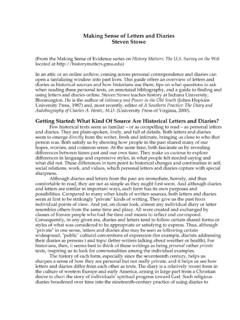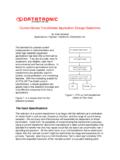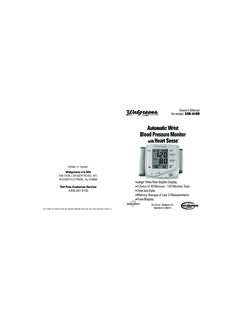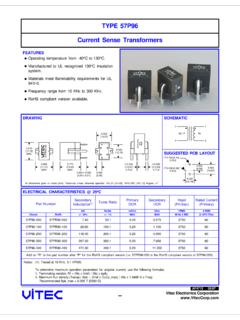Transcription of AN105 - Current Sense Circuit Collection Making …
1 Application Note 105AN105-1an105faDecember 2005 Current Sense Circuit CollectionMaking Sense of CurrentTim Regan, Jon MunsonGreg Zimmer, Michael StokowskiL, LT, LTC, LTM, Linear Technology, the Linear logo, Over-The-Top and TimerBlox are registered trademarks and Hot Swap is a trademark of Linear Technology Corporation. All other trademarks are the property of their respective owners. INTRODUCTIONS ensing and/or controlling Current flow is a fundamen-tal requirement in many electronics systems, and the techniques to do so are as diverse as the applications themselves. This Application Note compiles solutions to Current sensing problems and organizes the solutions by general application type. These circuits have been culled from a variety of Linear Technology Organized by General ApplicationEach chapter collects together applications that tend to solve a similar general problem, such as high side Current sensing, or negative supply sensing.
2 The chapters are titled accordingly. In this way, the reader has access to many possible solutions to a particular problem in one place. It is unlikely that any particular Circuit shown will exactly meet the requirements for a specific design, but the sug-gestion of many Circuit techniques and devices should prove useful. To avoid duplication, circuits relevant to multiple chapters may appear in one location. Circuit Collection INDEXn Current Sense Basicsn High Siden Low Siden Negative Voltagen Unidirectionaln Bidirectionaln ACn DCn Level Shiftingn High Voltagen Low Voltagen High Current (100mA to Amps)n Low Current (Picoamps to Milliamps)n Motors and Inductive Loadsn Batteriesn High Speedn Fault Sensingn Digitizingn Current Controln Precisionn Wide RangeApplication Note 105AN105-2an105faThis chapter introduces the basic techniques used for sensing Current .
3 It serves also as a definition of common terms. Each technique has advantages and disadvantages and these are described. The types of amplifiers used to implement the circuits are SIDE Current SENSING (Figure 1) Current sensed in the ground return path of the power connection to the monitored load. Current generally flows in just one direction (unidirectional). Any switching is performed on the load-side of monitor. +ILOADISENSELOADOUTPUT ILOADDC VSUPPLYVCCRSENSELow Side Advantagesn Low input common mode voltagen Ground referenced output voltagen Easy single-supply designLow Side Disadvantagesn Load lifted from direct ground connectionn Load activated by accidental short at ground end load switchn High load Current caused by short is not detectedHIGH SIDE Current SENSING (Figure 2) Current sensed in the supply path of the power connection to the monitored load.
4 Current generally flows in just one direction (unidirectional). Any switching is performed on the load-side of monitor. +ILOADISENSELOADOUTPUT ILOADDC VSUPPLYRSENSE +ILOADISENSEOUTPUT ILOADDC VSUPPLYVCCRSENSELOADCURRENT Sense BASICSF igure 1. Low Side Current SensingFigure 3. Full-Range (High And Low Side) Current SensingFigure 2. High Side Current SensingHigh Side Advantagesn Load is groundedn Load not activated by accidental short at power con-nection n High load Current caused by short is detectedHigh Side Disadvantagesn High input common mode voltages (often very high)n Output needs to be level shifted down to system operating voltage levelsFULL-RANGE (HIGH AND LOW SIDE) Current SENSING (Figure 3)Bidirectional Current sensed in a bridge driven load, or uni-directional high side connection with a supply side Advantagesn Only one Current Sense resistor needed for bidirec-tional sensingn Convenient sensing of load Current on/off profiles for inductive loads Full-Range Disadvantagesn Wide input common mode voltage swingsn Common mode rejection may limit high frequency accuracy in PWM applicationsApplication Note 105AN105-3an105faHIGH SIDEF igure 4.
5 LT6100 Load Current MonitorFigure 5. Classic Positive Supply Rail Current SenseFigure 6. Over-The-Top Current SenseThis chapter discusses solutions for high side Current sensing. With these circuits the total Current supplied to a load is monitored in the positive power supply Load Current Monitor (Figure 4)This is the basic LT6100 Circuit configuration. The internal circuitry, including an output buffer, typically operates from a low voltage supply, such as the 3V shown. The moni-tored supply can range anywhere from VCC + up to 48V. The A2 and A4 pins can be strapped various ways to provide a wide range of internally fixed gains. The input leads become very Hi-Z when VCC is powered down, so as not to drain batteries for example. Access to an internal signal node (Pin 3) provides an option to include a filtering function with one added capacitor. Small-signal range is limited by VOL in single-supply F04 RSENSELT610081VS VS+ F3V65 FILTO LOAD+5V+ + +LT16375V200 200 2k0V TO TA02 VOUT = (2 )(ILOAD)Q12N3904 LOADILOAD +LT16373V TO 44V3VR1200 R22kVOUT(0V TO )Q12N39041637 TA06 LOADILOADVOUT(RS)(R2/R1)ILOAD = Classic Positive Supply Rail Current Sense (Figure 5)This Circuit uses generic devices to assemble a function similar to an LTC6101.
6 A rail-to-rail input type op amp is required since input voltages are right at the upper rail. The Circuit shown here is capable of monitoring up to 44V applications. Besides the complication of extra parts, the VOS performance of op amps at the supply is generally not factory trimmed, thus less accurate than other solutions. The finite Current gain of the bipolar transistor is a small source of gain Current Sense (Figure 6)This Circuit is a variation on the classic high side cir-cuit, but takes advantage of Over-the-Top input capability to separately supply the IC from a low voltage rail. This provides a measure of fault protection to downstream circuitry by virtue of the limited output swing set by the low voltage supply. The disadvantage is VOS in the Over-the-Top mode is generally inferior to other modes, thus less accurate. The finite Current gain of the bipolar transistor is a source of small gain High Side Current Sense (Figure 7)This Circuit takes advantage of the microampere supply Current and rail-to-rail input of the LT1494.
7 The Circuit is simple because the supply draw is essentially equal to the load Current developed through RA. This supply Current is simply passed through RB to form an output voltage that is appropriately Note 105AN105-4an105faHigh Side Current Sense and Fuse Monitor (Figure 8)The LT6100 can be used as a combination Current sen-sor and fuse monitor. This part includes on-chip output buffering and was designed to operate with the low supply voltage ( ), typical of vehicle data acquisition systems, while the Sense inputs monitor signals at the higher bat-tery bus potential. The LT6100 inputs are tolerant of large input differentials, thus allowing the blown-fuse operating condition (this would be detected by an output full-scale indication). The LT6100 can also be powered down while maintaining high impedance Sense inputs, drawing less than 1 A max from the battery SIDEP recision High Side Power Supply Current Sense (Figure 9)This is a low voltage, ultrahigh precision monitor featuring a zero-drift instrumentation amplifier (IA) that provides rail-to-rail inputs and outputs.
8 Voltage gain is set by the feedback resistors. Accuracy of this Circuit is set by the quality of resistors selected by the user, small-signal range is limited by VOL in single-supply operation. The voltage rating of this part restricts this solution to applications of < This IA is sampled, so the output is discontinuous with input changes, thus only suited to very low frequency measurements.+ LT1494RA1kRSENSE1 LOADILVS = TO 36V1495 TA09RB10k+_VO( )RBRAVO = IL RSFOR RA = 1k, RB = 10k, RS = 1 = 10 V/AOUTPUT OFFSET IS RB 10mVOUTPUT CLIPS AT VS VOILF igure 7. Self-Powered High Side Current SenseFigure 8. High Side Current Sense and Fuse MonitorFigure 9. Precision High Side Power Supply Current = 25 AVEEOUTDN374 F02 RSENSE2m FUSELT610081VS VS+BATTERYBUSA4 ADCPOWER F65 FILTO LOAD ++ +LTC68004567 OUT100mV/AOF F150 6800 TA01 ILOAD82 VREGULATOR3 LOADP ositive Supply Rail Current Sense (Figure 10)This is a configuration similar to an LT6100 implemented with generic components.
9 A rail-to-rail or Over-the-Top input op amp type is required (for the first section). The first section is a variation on the classic high side where the P-MOSFET provides an accurate output Current into R2 (compared to a BJT). The second section is a buffer to allow driving ADC ports, etc., and could be configured with gain if needed. As shown, this Circuit can handle up to 36V operation. Small-signal range is limited by VOL in single-supply Note 105AN105-5an105faCURRENT MONITOR OUTPUT0mA TO 1mA = 0V TO 1V+ LT1789A = 1 BIAS OUTPUTTO APDVIN10V TO F02b1k1%10 MCURRENT MONITOR OUTPUT0mA TO 1mA = 0V TO 1V+ 35 VLT1789A = 1 BIAS OUTPUTTO APDVIN10V TO 33 VAN92 F02a1k1%Measuring Bias Current Into an Avalanche Photo Diode (APD) Using an Instrumentation Amplifier (Figures 12a and 12b)The upper Circuit (a) uses an instrumentation amplifier (IA) powered by a separate rail (>1V above VIN) to mea-sure across the 1k Current shunt.
10 The lower figure (b) is similar but derives its power supply from the APD bias line. The limitation of these circuits is the 35V maximum APD voltage, whereas some APDs may require 90V or more. In the single-supply configuration shown, there is also a dynamic range limitation due to VOL to consider. The advantage of this approach is the high accuracy that is available in an SIDEF igure 10. Positive Supply Rail Current SenseFigure 11. Precision Current Sensing in Supply RailsFigure 12bFigure 12a +1/2 LT1366R1200 1366 R220kQ1TP0610 LVCCVO = ILOAD RS = ILOAD 20 ( ) +1/2 LT1366R2R1 Precision Current Sensing in Supply Rails (Figure 11)This is the same sampling architecture as used in the front end of the LTC2053 and LTC6800, but sans op amp gain stage. This particular switch can handle up to 18V, so the ultrahigh precision concept can be utilized at higher voltages than the fully integrated ICs mentioned.

















